The Secret iPad App
Looks like Facebook is about to turn iPad detection on in their iPhone app, because TechCrunch has discovered the fabled iPad app buried in the latest iPhone app update.
The author of this blog, James Robertson, passed away in April 2014. This blog is being maintained by David Buck (david@simberon.com).
Looks like Facebook is about to turn iPad detection on in their iPhone app, because TechCrunch has discovered the fabled iPad app buried in the latest iPhone app update.
Today's Smalltalk 4 You finishes off the update to installing Cincom's NC product by looking at the actual installation process. If you have trouble viewing it here in the browser, you can also navigate directly to YouTube. To watch now, click on the image below:
If you have trouble viewing that directly, you can click here to download the video directly. If you need the video in a Windows Media format, then download that here.
You can also watch it on YouTube:
Technorati Tags: smalltalk, visualworks, installation
Enclosures:
[st4u111-iPhone.m4v ( Size: 4848285 )]
I noticed this morning that the feed for our Fallout podcast only contained episodes 3-22 - when I set up support for the feed (a long time ago now), I defaulted it to 20 items. I just popped that limit up, so when iTunes updates, the full list of episodes should show up there. Of course, you can always visit the archive pages :)
Technorati Tags: fallout, that podcast
Interested in trying out SmallHarbor (for hosting a Seaside app)? Check out the first screencast they've put out.
This response from James Gosling on relational databases almost sounds reasonable:
In the enterprise space, things like Sandra and Baltimore and some of the NoSQL database. I’ve never got it when it comes to SQL databases. It’s like, why? Just give me a hash table and a shitload of RAM, and I’m happy. And then you do something to deal with failures. And you look at the way things like the NoSQL movement is. It’s various flavors of large scale distributed hash tables and trying to deal with massive scale and massive replication, and you can’t back up the database because no tape farm is big enough. And you find scale and reliability can fit together at the same time. So a bunch of those things are really cool.
Until you work on a real project, that is. I used to have pretty dismissive take on relational databases. Then I noticed (late in the game, sure, but sooner than Gosling, apparently) that people want reports.
Here's the thing: a non-relational database works if you have an isolated project, or don't have data that other people need reports on. If the data you have is of interest to anyone else in your organization, and you don't use a relational database? You just bought a world of report writing along with your oSQL database.
Technorati Tags: rdbms, enterprise

|
Today's Javascript 4 You. Today we'll take a look at the slideDown() function in JQuery - you can gradually slide content on a page instead of fading. If you have trouble viewing it here in the browser, you can also navigate directly to YouTube. Join the Facebook Group to discuss the tutorials. You can view the archives here. |
To watch now, click on the image below:
If you have trouble viewing that directly, you can click here to download the video directly. If you need the video in a Windows Media format, then download that here.
You can also watch it on YouTube:
Enclosures:
[js4u76-iPhone.m4v ( Size: 1369613 )]
Apple has always been about profit margin, but it used to be the case that they were also all about the user experience. Now that they are enforcing the "no link to outside stores" rule, they are all about a worse customer experience.
Someone ask Jobs this: do you really think that the extra margin you'll get from this rule will outweigh the irritation experienced by end users who suddenly have a less useful device with crappier features?
In a message to the vwnc mailing list, Travis Griggs has laid out the best explanation of how the VW UI works that I've ever seen - shedding light on the good, the bad and the ugly.
Technorati Tags: visualworks, wrapper
Today's Smalltalk 4 You continues the VA Smalltalk Seaside tutorial with a domain model that we'll be using for the tutorial. You can download the code as a file out here. If you have trouble viewing it here in the browser, you can also navigate directly to YouTube. To watch now, click on the image below:
If you have trouble viewing that directly, you can click here to download the video directly. If you need the video in a Windows Media format, then download that here.
You can also watch it on YouTube:
Today we'll continue with the Seaside tutorial using VA Smalltalk. To start, download this file - it's a file-out of the base application we'll be using in this tutorial. It contains the basic domain classes we'll be using:
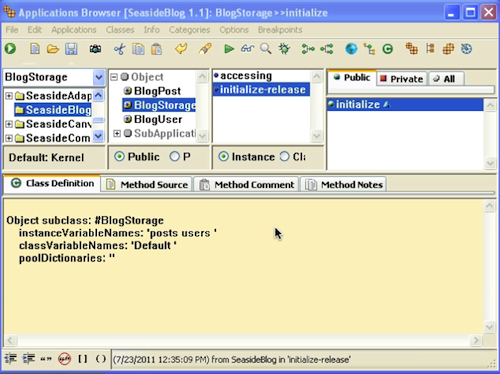
Before we can start building the Seaside part of this application, we need to examine the application. If SeasideComponentApp is not a pre-requisite, then the class
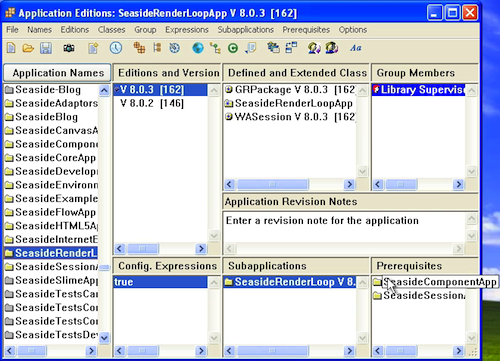
Now you'll just need the domain classes in the linked file above - BlogStorage, BlogPost, and BlogUser. To keep things simple, we'll be storing posts in a class variable collection in BlogStorage. That's so that we can concentrate on the Seaside part of things rather than anything else:
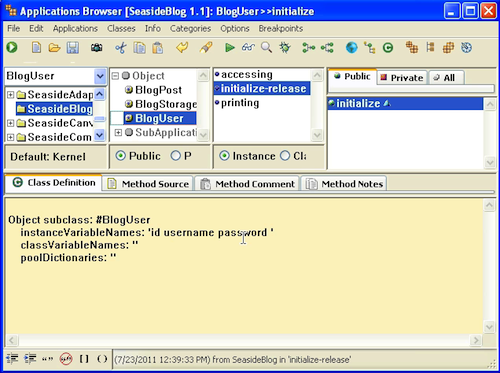
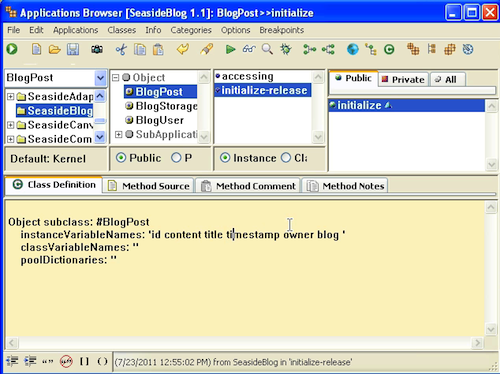
In the next section, we'll start in on the first view component.
Need more help? There's a screencast for other topics like this which you may want to watch. Questions? Try the "Chat with James" Google gadget over in the sidebar.
Technorati Tags: smalltalk, va smalltalk, seaside
Enclosures:
[st4u112-iPhone.m4v ( Size: 3893211 )]
interesting thoughts on who took what ideas from Smalltalk, from Bruce Badger

|
Today's Javascript 4 You. Today we continue looking at slideDown() in JQuery. If you have trouble viewing it here in the browser, you can also navigate directly to YouTube. Join the Facebook Group to discuss the tutorials. You can view the archives here. |
To watch now, click on the image below:
If you have trouble viewing that directly, you can click here to download the video directly. If you need the video in a Windows Media format, then download that here.
You can also watch it on YouTube:
Technorati Tags: javascript, jquery, tutorial
Enclosures:
[js4u77-iPhone.m4v ( Size: 1666376 )]
Today's Smalltalk 4 You continues the VA Smalltalk Seaside tutorial with the first visual component for the blog server application. You can download the initial domain model as a file out here. If you have trouble viewing it here in the browser, you can also navigate directly to YouTube. To watch now, click on the image below:
If you have trouble viewing that directly, you can click here to download the video directly. If you need the video in a Windows Media format, then download that here.
You can also watch it on YouTube:
Today we'll start building the first component that will make up the main entry point for our Seaside application. Before we can get started, we need to create an open edition of our application:
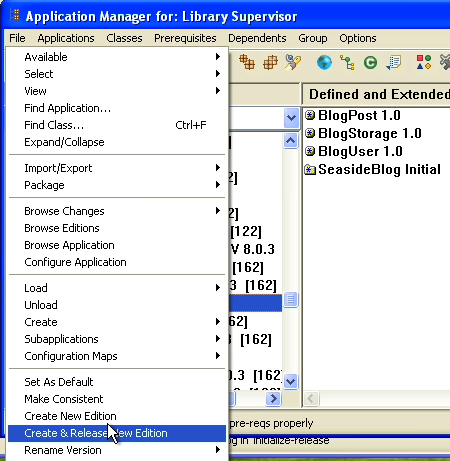
Once you've done that, you'll see that the latest edition has a timestamp rather than a version - that shows that it's open (i.e., it can be modified):
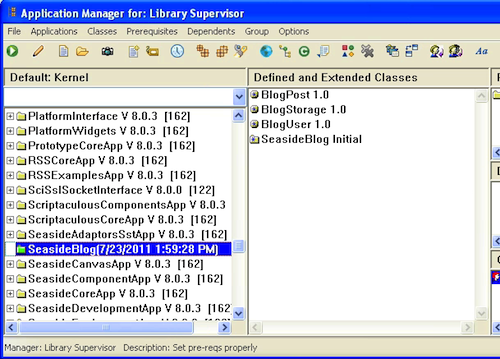
Next, we'll create a new subclass of WAComponent, and call it BlogServerView. This class needs two instance variables - listComponent and menuComponent. We'll set up the #initialize method to work with two additional components that we'll also create - BlogListView and BlogMenuView. Seaside uses component based assembly, so we proceed as follows: create a container view, which in turn will hold references to all the views that need to render within it.
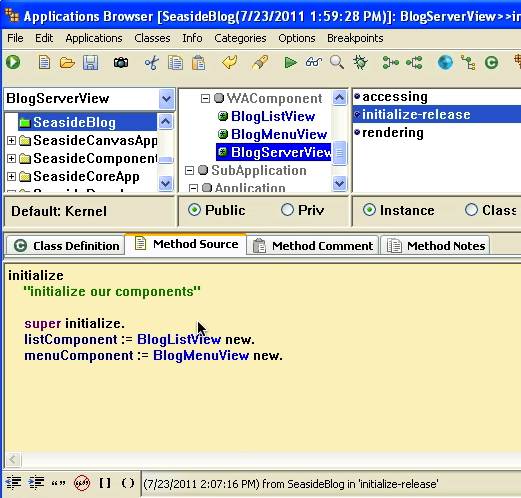
The #initialize method looks like this:
initialize "set up our basic components" super initialize. listComponent := BlogListView new. menuComponent := BlogMenuView new.
At this point, you should also have defined two other subclasses of WAComponent - BlogListView and BlogMenuView. The first of these (BlogListView) needs one instance variable, entries. With that all done, we can get to the rendering part - #renderContentOn: in BlogServerView:
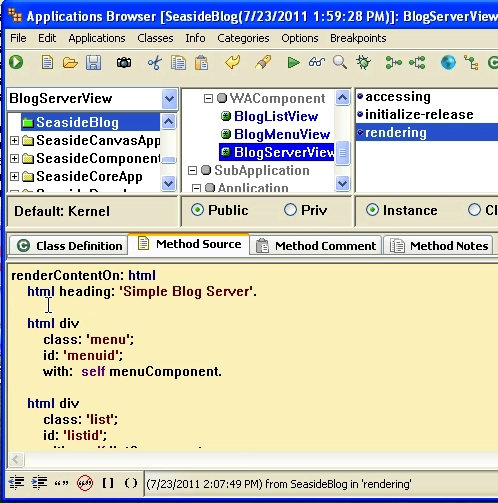
That code looks like this:
renderContentOn: html html heading: 'Simple Blog Server'. html div class: 'menu'; id: 'menuid'; with: self menuComponent. html div class: 'list'; id: 'listid'; with: self listComponent.
We need one more method - typically an #initialize method on the class side of the main view class. In this case, we'll add it to BlogServerView, and then execute the comment:
initialize
"BlogRootUI initialize"
WAAdmin
register: self
asApplicationAt: 'blogView'.
With that done, bring up a web browser and navigate to the port you are running the server on (8080 if you took the default):
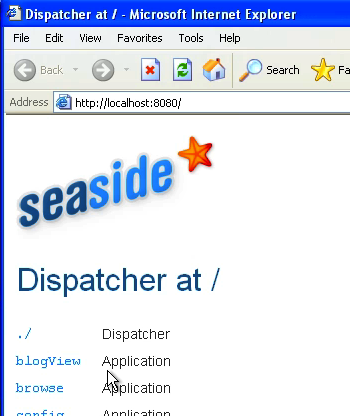
Notice the new link to blogView? Click that, and you should see the following:
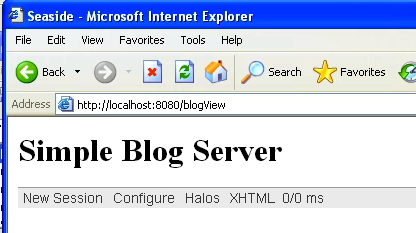
That wraps it up for now. In the next section, we'll take a look at building out the sub-components
Need more help? There's a screencast for other topics like this which you may want to watch. Questions? Try the "Chat with James" Google gadget over in the sidebar.
Technorati Tags: smalltalk, va smalltalk, seaside
Enclosures:
[st4u113-iPhone.m4v ( Size: 5996855 )]
I must have spent more time in the method #moveEditVerticallyBy: (in DatasetView) over the last decade than anywhere else. Just today, I was notcing a problem in the keyboard navigation in one of our datasets - and the reason is this bit of code at the bottom of the method:
nextIndex == #changedIndex ifTrue: [^true]. self editAt: nextIndex downcast: false. self triggerEvent: #cellGettingFocus. self topComponent keyboardProcessor currentConsumer: editor widget controller. ^true
Note what's not there: a #valueChange sent to the controller. Without that, you get the bizarreness of the UI looking like it's selected, but the system doesn't actually register it as selected.
Now, that's in VW 7.6. In the latest release (7.8), this is fixed. Unfortunately, I'm not working in 7.8....
Technorati Tags: visualworks
The podcast will be in hiatus this weekend - I've been pretty busy, and haven't had time to put anything together. We'll be back next weekend with a new episode.
Technorati Tags: smalltalk
A while back, Airbnb (a "rent your home to strangers" service) had a nasty incident where some grifters took advantage of a user of the system and robbed her blind. I read about that on TechCrunch - and they asked Airbnb what they were going to do for the customer. When he got an equivocal answer, he said the understandable thing: they weren't guaranteeing any compensation at all. To which Graham responded:
The story Arrington wrote yesterday about Airbnb not offering to help was bullshit. He asked a company spokesman what Airbnb was doing to help her. The spokesman, who’d been told by their lawyers that he couldn’t go into detail about that because of the precedent said “I can’t comment on that.” So Arrington, in typical Arrington fashion said “Well, unless you tell me I’m going to write that you’re not willing to do anything for her.” And he did. Really not cool. I’ve talked to the Airbnb guys and they are already doing everything they could be doing to help this woman.
Well. I can only assume that Graham hasn't even heard of PR. When something bad happens to a customer, and the PR staff are only willing to come back with blather, what the heck does he expect?
 |
I just finished reading Griftopia I've read pretty widely on this subject, and I think this book is one of the few I've read that really tries to look under the hood, as it were. If you want an unsparing examination of what's gone wrong, this is one book you should definitely look at. |
One small caveat - if you're bothered by profanity, this book may not be for you. It's laced with it - in some ways, it reads more like a conversation than like typical prose. If you can get past that, it's worth a look. Also, check your ideology at the door. While my worldview and Taibbi's are pretty far apart, he doesn't spare anyone (or any party) in this book.
Technorati Tags: financial crisis
I've done a fair bit of posting (and screencasting) on this topic for VW - Torsten has covered the bases for Squeak and Pharo in a very impressive way.
Technorati Tags: deployment, squeak, pharo
Today's Smalltalk 4 You looks at code recovery using Pharo. Sometimes, you lose an image (crash, inadvertant quit without saving, power outage...) - and you really don't want to lose whatever code you've been working on. Today we'll look at how to recover your work using tools built into Pharo. If you have trouble viewing it here in the browser, you can also navigate directly to YouTube. To watch now, click on the image below:
If you have trouble viewing that directly, you can click here to download the video directly. If you need the video in a Windows Media format, then download that here.
You can also watch it on YouTube:
Technorati Tags: smalltalk, pharo, code recovery
Enclosures:
[st4u114-iPhone.m4v ( Size: 4317416 )]
The VMWare (Gemstone) folks are sponsoring a post-ESUG Seaside sprint:
The fine folks at VMware (formerly GemStone) are so kind to pay for the venue of the Seaside Sprint after ESUG in Edinburgh.